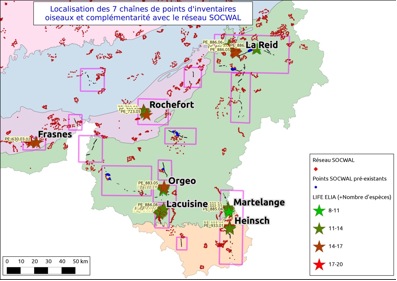News
2012-10-04
Bio-indicators : birds
The effectiveness of management and restoration methods implemented in the project can be estimated by monitoring groups as "bioindicators".
Such groups (birds, dragonflies, butterflies, bats, ...) are known to react quickly enough to changes in their habitats. In 2012, spring and summer were used to realize the first ornithological inventories. The goal was to have an initial inventory before completing the first actions. Birds are identified by an non-exhaustive method of inventory: the technique of « listening points ». The observer is placed at a defined spot and during 5 minutes, he notes all the birds seen and / or heard from that spot. The information collected is divided into three classes: hearing a song, simple contact (bird seen or heard), some nesting (nest, transport of materials or food ...). Each listening spot is visited twice each year. A total of 49 listening spots over 7 sites and three natural regions were determined (see map).

LIFE Project's listening spots have been integrated in the walloon commonplace birds surveillance network (SOCWAL).
They are positioned to complete the SOCWAL network on sites that hadn't been monitored yet. The ornithological inventories realized in 2012 have allowed to contact 50 species. The top 10 species most frequently encountered are the following:
- Chaffinch (Fringilla coelebs) : 38 sites/49

- Blackcap (Sylvia atricapilla) : 38/49
- Chiffchaff (Phylloscopus collybita) : 38/49
- Wren (Troglodytes troglodytes) : 32/49
- Blackbird (Turdus merula) : 30/49

- Woodpigeon (Columba palumbus) : 28/49
- Willow Warbler (Phylloscopus trochilus) : 26/49
- Goldcrest (Regulus regulus) : 23/49
- SongThrush (Turdus philomelos) : 22/49
- Coal Tit (Parus major) : 22/49

In contrast to the classification, we found a few species whose nesting area in our region and number of nests are rather limited: the Siskin (6sites/49) and Redpoll (3sites/49). Some emblematic species were also encountered:
the Black Stork (ciconia nigra),

Raven (Corvus corax)

or the Peregrine falcon (Falco peregrinus) !
Inventories by listening points will continue the next year and beyond as Elia LIFE project developments will be gradually managing and changing the edges. Bird communities can therefore be observed in the medium or long term.




